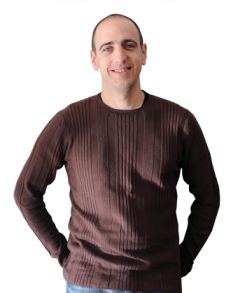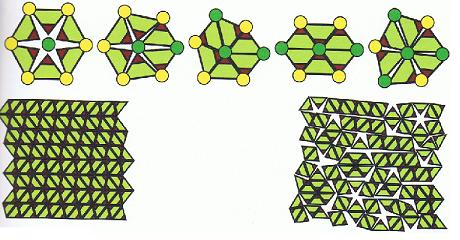Guest of the section: Dr. Yair Shukof, Department of Physics of Complex Systems "A model of frustration in matter may give scientists significant insight into the behavior of particles in many types of real materials"

It is difficult to host a large number of people for dinner, and ensure that everyone is satisfied. A host who tries to arrange his guests around a table with an odd number of sides (e.g. a triangle), so that on either side of each man sit women, while on either side of each woman sit men, simply will not succeed in doing so, which will cause some guests to be frustrated. On the other hand, if he chooses square tables, he can succeed in the task and everyone will be happy. Even in nature, the packaging structure, it turns out, plays a central role in the ability to avoid frustration.
Here is another example: a third person who joins an intimate dinner of two partners usually causes frustration. Unfortunately, not everyone understands this. It turns out that the phenomenon of the "frustrating third factor" also exists in the material world, and especially in the world of anti-ferromagnetic materials. In these materials, each particle has a magnetic spin ("spin") that causes it to "point" in a certain direction. The organization of the particles in the material crystal is done so that each particle prefers its spin direction to be opposite to that of its neighbors. One of the efficient ways to arrange the particles is to "pack" them in triangles. However, a block of material that contains triangular motifs will cause two of the three particles in each triangle to be placed next to particles with the same spin direction as theirs - and this is a recipe for continuous frustration. Therefore, many materials are "looking" for other ways of organization, which will allow the particles to rotate and change their spin directions, with the aim of finding an organization in which the rule of non-adjacency between particles with the same spin direction will be fulfilled. Often, the inability of matter to organize itself according to the opposite spin direction rule leads to persistent frustration, which in turn will result in complete disorder.
Until recently, no one was able to observe the dynamics of individual atomic particles seeking a way out of their frustrated states. But Dr. Yair Shokoff, a post-doctoral researcher who recently joined the group of Prof. Grigori Falkovich, head of the physics department of complex systems at the Weizmann Institute of Science, brought with him new insights in this field. During his previous research period, in the research groups of Prof. Arjun Yod and Prof. Thom Lubansky at the University of Pennsylvania, Dr. Shokoff participated in the production of a model system of frustrated particles whose size made it possible to observe it in real time through a microscope. This system was made of tiny balls trapped in a very thin layer of water. The spheres had little freedom to move up and down, and their natural tendency was to place themselves at the greatest possible distance from the other spheres (to increase their "personal space" as much as possible). The two states, up and down, are similar to the opposite spin directions in antiferromagnetic systems. The balls are made of a special material, so that a slight drop in temperature causes them to swell, which allows scientists to look at phenomena that occur in a material undergoing a change such as cooling, which causes the particles to crowd together and organize into a "tighter" structure.
The findings of this study, recently published in the scientific journal Nature, show that a frustrated system will not necessarily reach a state of total disorder. Instead, the top and bottom particles line up in patterns of squiggly lines that have order in one direction and randomness in the other. "The geometry is relatively simple," says Dr. Shokaf. "In the curled layer, which is formed as a result of the particles moving up and down, each triangle formed by three adjacent particles will be distorted. Instead of an equilateral triangle (which would exist if all the particles were placed in one plane), they form isosceles triangles, where only two of the sides are equal - and not all three. Tiling arrangements of equilateral triangles will look the same no matter how the triangles are placed. But different combinations of isosceles triangles yield different shapes, and only one or two of these shapes are useful for packing particles effectively." When the researchers looked at the possible configurations of six spheres surrounding one central sphere in a state of constant increase in density, they found that in some arrangements, the central spheres were more stable and less inclined to change their spin directions. Dr. Shokoff: "This model of frustration in a material may give scientists significant insight into the behavior of particles in many types of real materials, including those that stabilize in a glass-like structure and antiferromagnetic materials with elastic properties."

In short: the question: is it possible to host a large number of people for dinner, and make sure that everyone will be satisfied? Is it possible to avoid frustration caused by the presence of a third person at a meeting of spouses? And what does this mean about the organization of blocks of matter?
The findings: This model of material frustration may give scientists significant insight into particle behavior in many types of real materials.

5 תגובות
So what are the insights of the model about the behavior of particles of materials?
http://www.nature.com/nature/journal/v456/n7224/abs/nature07595.html
someone something:
I saw that (although it is not spin but its replacement which is the height) but that is not the point.
I am interested in the colors of the surfaces and especially the white "spaces".
To 1:
As far as I understood, the colors (green and yellow at the vertices of the thirty) are supposed to indicate spin.
That is, all the greens have the same spin, and all the yellows have the same spin.
An explanation of the meaning of the colors in the picture would have been helpful